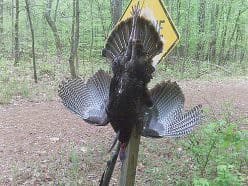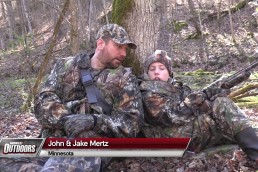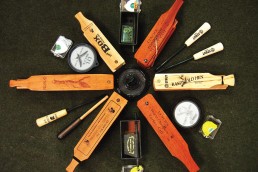Patterning Your Turkey Gun
SHARE THIS POST
It’s that magical time of year: spring turkey season is upon us. Turkey hunters across the Midwest are scheduling vacation time, practicing calls, getting their gear ready and making plans to bag a limb-hanger.
Take a minute and think back. Have you ever missed a gobbler, or even worse, hit one and he got away? Every year, good hunts come to an end and frustrated hunters walk away with an empty feeling inside. If you’ve hunted long enough, it’s happened.
Knowing the pattern of your turkey gun is very important for success in the field. Turkey hunters should spend time on the range, shooting and evaluating their shot patterns. The goal is to find a turkey load that puts multiple pellets in the kill zone of a turkey consistently. It takes a direct hit to the nervous system (brain and spinal cord) to put a turkey down quickly. Practicing different shotshell loads at various distances will help you determine the right load for your turkey gun. Whether you need to figure out the “perfect” load or just want to practice and reaffirm what you already know, here tips for confident shooting.
Shoot from a rest
Prepare to pattern your shotgun like you were sighting in a deer rifle. Use some type of solid shooting rest, such as a lead sled or even sand bags. Set up on a shooting bench or portable table.
Shooting from a stationary position takes part of the human error out of the picture. Some guns that “kill on both ends” can deliver quite a kick to the shoulder of the shooter, helping eliminate potential flinching.
Use turkey targets
Pick up targets from a sporting goods store that sells turkey-hunting supplies. You should find a printed color target with a life-size gobbler’s head. It will also show the vitals inside the head. Shooting these types of targets will show how many pellets strike the brain and spinal cord areas consistently.

If you don’t want to make the purchase, go online and search “printable turkey targets.” You can find a variety of targets that can be printed out on sheets of paper 8 1/2 by 11 inches.
Check your sights first
It’s best to set the first target up close—10 to 15 yards—and use low brass shells such as pheasant or quail loads. Shoot at this close distance to verify that your sights are on target and the low brass shells will be better for both the shoulder and the pocket book.
With factory extra full or modern aftermarket chokes, patterns can be tight. It is important to know that your gun is dead-on. If you find any variances in the sights and shot placement, make adjustments now before moving on and checking patterns.
Shoot a variety of shells
Mix it up with different shot sizes and different brands of turkey shells. Try the traditional 4 or 5 shot. Some hunters even go with number 6. You can find these in lead, copper-plated lead and in materials like hevi-shot, which is heavier than lead and composed of tungsten, nickel and iron. Be aware: only shoot hevi-shot in barrels of guns that can handle steel shot.
Thanks to new technology and developments in modern shotshells, hunters have choices of blended ammo. These combinations of different shot sizes in a single load combined with buffers that hold shot together longer out of the barrel are now readily available.
Although turkey loads can be expensive, you should still test several different shells. And there are a couple things you can do to keep the costs down.
Are you enjoying this post?
You can be among the first to get the latest info on where to go, what to use and how to use it!
First, research your shotgun and choke combination online. Firearm and choke manufacturers have started posting recommendations for shell and shot sizes. Someone has probably already done the homework. Second, find a hunting buddy or two and go in together on different brands of ammo, this will make it easier on your wallet.
Shoot at distances you will hunt
Start out shooting patterns at 40 yards. This is about the maximum recommended distance to squeeze off a shot at a gobbler and take him out quickly. Although turkeys can be killed at farther distances with modern magnum loads and choke tubes, I still go with 40 yards as my max. With this in mind, if you make an error in judgment and take a shot a little past 40, you’ll still be covered.
Begin shooting at your maximum distance and check the patterns of all the shells you want to try. Starting out at this distance will cull any shells that do not pattern well. If they don’t do well at 40 yards, you may not want to waste time with the shell at 20 and 30 yards. You can pass on shells that don’t do well for you to your hunting buddies—that same shell may be great for them.
Once you’ve found the perfect 40-yard load, it’s time to move in closer. Set your targets at 30 yards, then 20 yards. These are all realistic distances that hunters will face when getting ready to draw down on an old tom. One more distance you may want to pattern is at 10 yards. If you turkey hunt long enough, you could find yourself in this extremely close circumstance. It’s good to know how tight the pattern is, as it may be baseball-sized or softball-sized at most, and there is little margin for error.
Evaluating your patterns
After each shot, write any pertinent information on the target: yardage, ammo brand, shot size, ounce load, shell length, gauge and choke. You should end up with a shot and patterned turkey target for each shell at every distance.
At 40 yards you’re looking for a uniform pattern that will put at 18 or more pellets in the head and neck area of the turkey. At 30 yards you’ll want to see a pattern with 30 or more in the kill zone, and at 20 yards there should be over 50.
Lay all your shot targets out in one place and compare the different shells and yardages. After you’ve narrowed it down to the shell of your choice, turn the turkey target over and look at the backside. This side is blank and you can easily see the density of the shot pattern.
Keep all of the patterned targets for future reference. If your memory is like mine, you won’t remember all the patterns a year from now.
If you aren’t satisfied with the patterns you’re getting, keep at it. Try other brands of ammo, take recommendations from other turkey hunters or from turkey hunting forums online. You can also try a tighter constriction choke tube if your gun has interchangeable chokes. Borrow one from hunting buddies with the same model gun, if that’s an option. If you have to purchase one, make sure its exit diameter is tighter than the one you’ve patterned.
Remember that no two guns will pattern the same, even among the same makes and models. Put in the time to find the perfect load and turn your shotgun into a turkey-killing machine.
Patterning your gun is only part of the formula for success in the turkey woods, but it’s a very important part. Take these tips to heart and you’ll shoulder more gobblers than ever.
For more information…
Free online printable turkey targets are available at hunterslink.com and winchester.com.
MWO
SHARE THIS POST
Did you enjoy this post?
You can be among the first to get the latest info on where to go, what to use and how to use it!
Andy Douglas
Andy Douglas is an avid hunter, outdoor writer, and photographer. He has been chasing whitetails, big toms, bass, and most game that can be had for over 35 years. He lives the outdoor lifestyle and is passionate about sharing with others through stories and photos. Email him at AndyDouglas.Outdoors@yahoo.com



